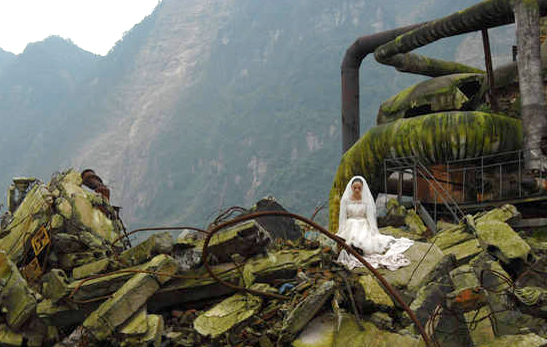Using the raw materials from the devastation of her hometown, a camera and a limited knowledge of cinematography, Chinese artist Chen Qiulin turned a disastrous situation into a moving work of art.
Chen Qiulin currently has an exhibition at the Hammer Museum until Jan. 3. Her work documents the vast changes occurring in her home province of Sichuan, located in southwestern China. The Hammer Museum is currently showcasing two of her videos, “Peach Blossom” and “The Garden.”
“In a way, they’re like a docudrama. She’s trying to tell you the history of herself and her country, and about a very recent past,” said Josie Browne, director of the Max Protetch Gallery that represents Qiulin’s work.
The films explore the destruction and modernization of Wanxian, Qiulin’s hometown. “The Garden” examines the aftermath of the flooding of the Three Gorges Dam in 2007, while “Peach Blossom” shows the ruins of the 2008 Wenchuan earthquake.
“She was flabbergasted by the destruction around her, which represented all her childhood memories being smashed,” said France Pepper, director of arts and culture programs at China Institute in New York.
Yet “The Garden” also conveys a sense of hope for what is yet to come, even though it focuses on the difficulty of starting over again. The film shows people returning to a more modernized town after the dam was constructed, where the main focus is on two actors carrying huge bouquets of fake peonies around town.
The peony, a national emblem of China, can symbolize love, beauty or wealth, among other things.
Qiulin also shows the tension between the modern city and its traditional citizens, demonstrated in the film as the actors wash their clothing in the river, despite the surrounding high rises.
“Peach Blossom” is split into four parts: Searching, Walking, The Wedding, and The Being. The camera follows around a couple, dressed in wedding attire, as they walk through the town and witness the damage of the earthquake after Sichuan has been destroyed again. There is a raw sense of loss and hopelessness, as the camera pans around to shows inhabitants living in tent-like structures or with no shelter at all.
“There’s great sadness in it, and there’s great beauty about people and hope and life, and it really kind of elevates people. It has a pure heart of feeling for people,” Brown said.
Qiulin also juxtaposes the old with the new in this film, as she introduces another couple, dressed in ancient Sichuan opera costume. The contrast between the two couples shows the cultural struggle of older, more traditional generations are battling in the face of modernization. Despite the evident despair and confusion, the film still maintains a sense of hope in the ideas of marriage and love that are sprinkled throughout.
“It’s in a way like a bridge between the old and the new. (There is) destruction of the old, and the rebuilding of the new. They’re trying to build a new, modern city,” said James Elaine, the curator for this exhibit.
Because the themes of loss, starting anew, and the effects of urbanization are so universal, Qiulin’s films are relatable and relevant to all kinds of people.
“Her work is talking about very human dilemmas and situations that we can all relate to,” Elaine said.
Qiulin has been showing her artwork all over the world, in places such as Chicago, Korea and Beijing.
However, her homeland too is eager to establish their own art culture ““ another indication of the rapidly evolving culture.
“Her own homeland wants to build up their galleries and museums, and I’d love to see that happen,” Browne said.
